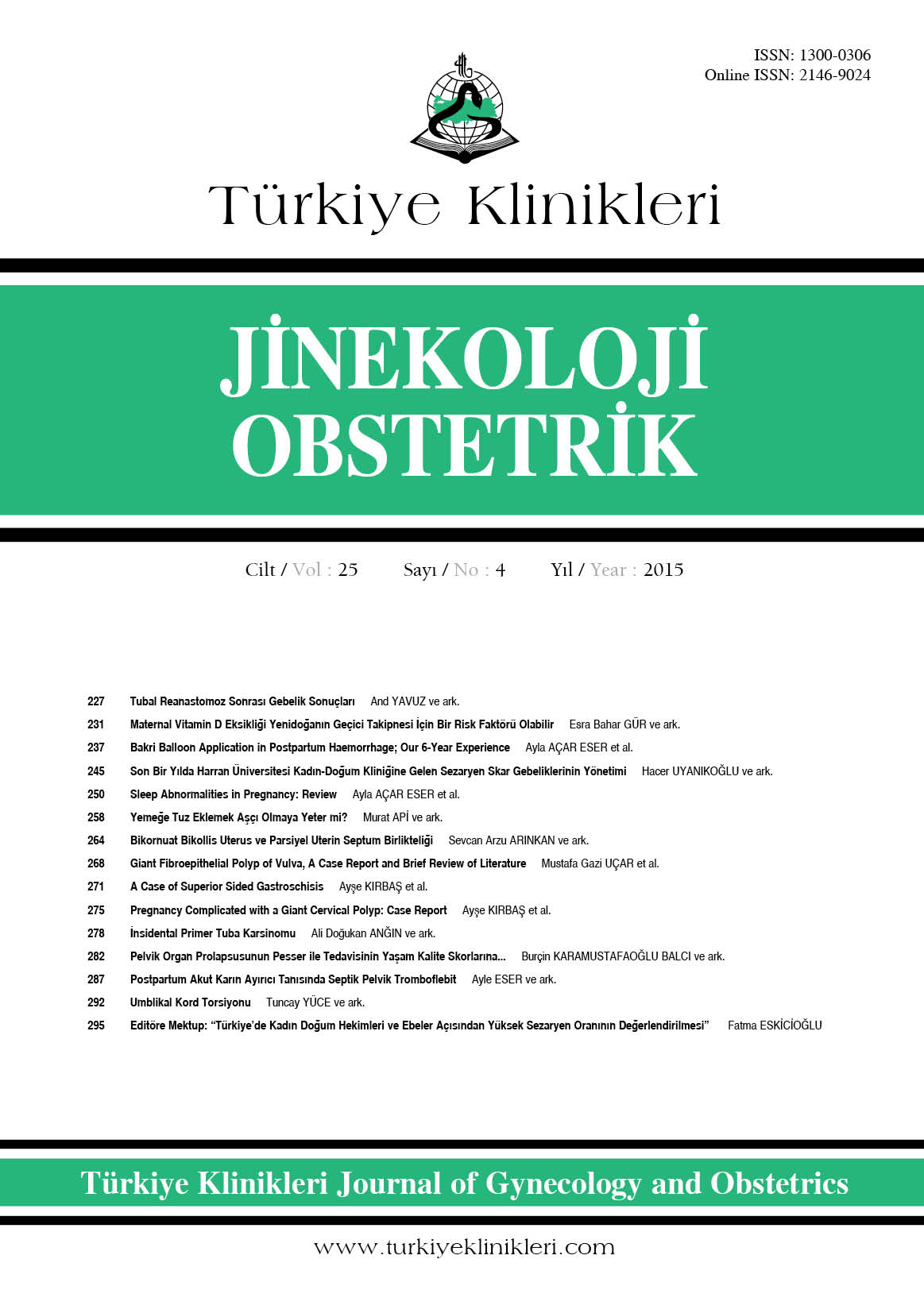Open Access
Peer Reviewed
CASE REPORTS
4202 Viewed2182 Downloaded
The Impact of the Treatment of Pelvic Organ Prolapse with Pessary on Quality of Life and Visual Analog Scale-Case Series
Pelvik Organ Prolapsusunun Pesser ile Tedavisinin Yaşam Kalite Skorlarına ve Görsel Analog Skala Sonuçlarına Etkisi-Olgu Serisi
Turkiye Klinikleri J Gynecol Obst. 2015;25(4):282-6
DOI: 10.5336/gynobstet.2014-42328
Article Language: TR
Article Language: TR
Copyright Ⓒ 2025 by Türkiye Klinikleri. This is an open access article under the CC BY-NC-ND license (http://creativecommons.org/licenses/by-nc-nd/4.0/)
ÖZET
2010-2012 yılları arasında pesser tedavisi uygulanmış 18 hastanın dosyası retrospektif olarak analiz edildi. Olgulara telefonla ulaşıldı ve pesser tedavisi sonrasında prolapsus yaşam kalite anketi (PYKA) ve pelvik taban etkilenme anketi (PTEA) ni doldurmaları istendi. Telefonla altı olguya ulaşıldı ve olguların tedavi öncesinde ve sonrasında miksiyon güçlüğü, üriner inkontinans ve prolapsus açısından şikayetlerini veya memnuniyetlerini görsel analog skala ile değerlendirmeleri istendi. 6 hastanın yaş ortalaması 69±15,06'dır. Altı olgunun ortalama pesser kullanma süresi 7,17 aydır. Tedavi sonrası PYKA skoru ortalaması 86,57'dir. Tedavi sonrasında beş olgunun PTEA skoru 0 iken, bir olgunun ise 2'dir. Görsel analog skala ile değerlendirildiğinde pesser kullanımı sonrası tüm olguların üriner inkontinans ve prolapsus şikâyetlerinde azalma meydana geldi. Pesser prolapsus semptomlarında iyileşme, hayat kalitesinde artış sağlamaktadır. Pesser, üriner inkontinansı da tedavi edebilir. Pesser tedavisi, hem noninvaziv hem ekonomik, hem de hemen etkili olması sayesinde çok avantajlı bir tedavi yöntemidir.
2010-2012 yılları arasında pesser tedavisi uygulanmış 18 hastanın dosyası retrospektif olarak analiz edildi. Olgulara telefonla ulaşıldı ve pesser tedavisi sonrasında prolapsus yaşam kalite anketi (PYKA) ve pelvik taban etkilenme anketi (PTEA) ni doldurmaları istendi. Telefonla altı olguya ulaşıldı ve olguların tedavi öncesinde ve sonrasında miksiyon güçlüğü, üriner inkontinans ve prolapsus açısından şikayetlerini veya memnuniyetlerini görsel analog skala ile değerlendirmeleri istendi. 6 hastanın yaş ortalaması 69±15,06'dır. Altı olgunun ortalama pesser kullanma süresi 7,17 aydır. Tedavi sonrası PYKA skoru ortalaması 86,57'dir. Tedavi sonrasında beş olgunun PTEA skoru 0 iken, bir olgunun ise 2'dir. Görsel analog skala ile değerlendirildiğinde pesser kullanımı sonrası tüm olguların üriner inkontinans ve prolapsus şikâyetlerinde azalma meydana geldi. Pesser prolapsus semptomlarında iyileşme, hayat kalitesinde artış sağlamaktadır. Pesser, üriner inkontinansı da tedavi edebilir. Pesser tedavisi, hem noninvaziv hem ekonomik, hem de hemen etkili olması sayesinde çok avantajlı bir tedavi yöntemidir.
ABSTRACT
The data of 18 patients who were treated with pessary between 2010 and 2012 was retrospectively analyzed. All patients were interviewed on the phone. The patients were asked to fill the prolapsus quality of life (QoL) and urinary distress inventory (UDI) form and to evaluate their satisfaction about urinary retension, urinary incontinence and prolapse with visual analogue scale. The interviewer could reach six patients. The mean age was 69±15.06. The mean period of pessary use was 7.17 months. The mean score of prolapsus QoL questionnaire after the treatment was 86.57. five patients' UDI score was 0 after the treatment and one patient's score was 2. Visual Analogue Scale results showed that all patients' incontinence and prolapse symptoms had been improved after the treatment but one patient was complaining of urinary retension. Pessary use improved prolapse symptoms and quality of life of the patients and can also treat urinary incontinence.
The data of 18 patients who were treated with pessary between 2010 and 2012 was retrospectively analyzed. All patients were interviewed on the phone. The patients were asked to fill the prolapsus quality of life (QoL) and urinary distress inventory (UDI) form and to evaluate their satisfaction about urinary retension, urinary incontinence and prolapse with visual analogue scale. The interviewer could reach six patients. The mean age was 69±15.06. The mean period of pessary use was 7.17 months. The mean score of prolapsus QoL questionnaire after the treatment was 86.57. five patients' UDI score was 0 after the treatment and one patient's score was 2. Visual Analogue Scale results showed that all patients' incontinence and prolapse symptoms had been improved after the treatment but one patient was complaining of urinary retension. Pessary use improved prolapse symptoms and quality of life of the patients and can also treat urinary incontinence.
MENU
POPULAR ARTICLES
MOST DOWNLOADED ARTICLES





This journal is licensed under a Creative Commons Attribution-NonCommercial-NoDerivatives 4.0 International License.










